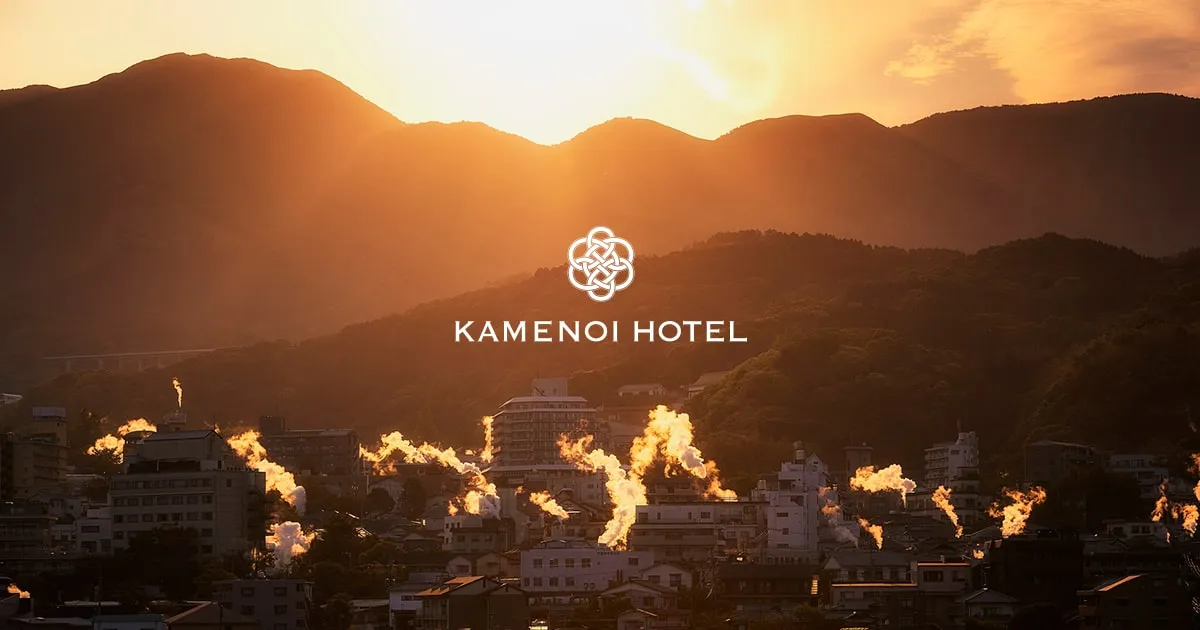Choosing where to stay in Japan isn’t just about booking a bed.
It’s part of the journey—and it deserves some real thought.
From capsule hotels to luxury ryokan, the choices are so varied
that you might find yourself stuck in an endless spiral of hotel comparisons.
When that happens, try shifting your focus.
Instead of just thinking about what you’ll spend (your budget),
ask yourself what you want to experience—and what you might gain.
In this guide, we’ll break down the main types of accommodations in Japan,
not just in terms of price, but also what kind of experience each one offers.
And along the way, I’ll share a few stories and impressions from my own travels in Japan.
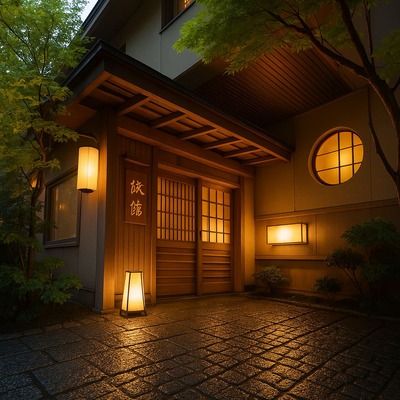
1. What Your Stay in Japan Will Feel Like – Accommodation Types in Japan
1-1. Business Hotels
Business hotels in Japan are everywhere—and they’re exactly what they sound like.
Simple, efficient, no-frills places designed for people who are here to work, sleep, and repeat.
They’re usually affordable—starting at around $40 USD per night.
You won’t find any infinity pools or rooftop bars,
but you will get a clean room, a firm bed, a unit bath, and perhaps a breakfast set
with a suspiciously perfect scrambled egg.
What really defines a business hotel, though, is its compact efficiency.
A typical single room is about 110 to 140 square feet,
while a double might go up to around 200 square feet at most.
It’s tight, but highly functional.
In fact, if you’re a solo male traveler, you might find the size oddly nostalgic—
like a grown-up version of a childhood secret base.
Everything within arm’s reach. A little world of your own. Not bad at all.
Even couples might find that the tight space creates a kind of quiet closeness—
not because you’re squeezed together, but because there’s nothing else to do but relax… together.
Major chains include Toyoko Inn and APA Hotel, among others.
1-2. Mid-Range Hotels
These hotels typically start around $80 USD per night and are often bundled with package tours for domestic travelers.
They’re especially popular among Japanese families, thanks to their balance of comfort, amenities, and affordability.
They’re so familiar that many Japanese people have childhood memories of family trips staying in this very type of hotel.
Dinner options range from simple to more elaborate meals depending on the price,
and breakfast is often served buffet-style in a large hall—eggs, rice, miso soup, sausage, and more.
Service is usually efficient and friendly, and above all, there’s a quiet sense of security that everything will go smoothly.
Many mid-range hotels also feature communal baths or hot springs, which can be a great way to unwind after a day of sightseeing.
One example is Kamenoi Hotel, a national chain known for its affordable pricing and family-friendly atmosphere.
It’s not fancy, but it gets the job done—think of it as the Honda Civic of Japanese hotels.
1-3. Luxury Resort Hotels
If you’re ready to splurge and want to enjoy spacious rooms, meticulous service, and a sense of complete escape from everyday life,
a luxury resort hotel might be just the thing.
These hotels don’t always feel particularly “Japanese” in style,
but they make up for it with full-course dinners, thoughtfully crafted breakfasts, stylish lounges, aroma massages,
and open-air bars practically begging to be photographed at sunset.
It’s the kind of pampering that makes you feel a little guilty… but in a good way.
Yes, it’s an investment.
But if it turns into a story you and your partner will still be swooning over ten years from now,
maybe—just maybe—it was worth every yen. (Or at least, that’s what you can tell yourself.)
To be fair, Japan—aside from Okinawa—isn’t overflowing with “resort” destinations,
so most travelers don’t build their whole itinerary around these kinds of hotels.
But spending a night or two in full-on indulgence? Absolutely worth considering.
Among these, Hoshino Resorts stands out as the most widely recognized name.
They run a variety of hotel brands, but at the top, the Hoshinoya series offers uniquely designed, high-end experiences that are hard to forget.
Just one warning: they’re incredibly popular—so book well in advance.
1-4. International Hotel Chains
If what you’re looking for is consistency, brand-name recognition, and the kind of service where absolutely nothing goes wrong—
an international hotel chain like Hilton, Marriott, or Hyatt might be your safest bet.
These hotels are typically located in major cities and business hubs.
Meals are often not included, but you’ll find polished restaurants on-site and reliable room service available around the clock.
Cleanliness and professionalism are guaranteed, and the staff is used to handling international guests.
That said, rooms may feel surprisingly compact compared to their overseas counterparts, and prices—especially for meals and services—tend to be on the steep side.
And while you’ll sleep comfortably, you won’t exactly feel like you’re in Japan.
It’s less “immersive experience,” more “international standard.”
If you’re the kind of traveler who prefers zero surprises, that may be just what you want.
But for many people visiting Japan, a stay at one of these hotels can feel a bit… generic.
Reliable? Absolutely. Memorable? Maybe not.
1-5. Luxury Ryokan
Not all places that call themselves a “ryokan” truly offer the traditional experience—
some budget ryokans are basically just hotels with a different name.
Here, we’ll focus on true luxury ryokan, which typically cost several hundred dollars per night and deliver something far more special.
And to put it simply: I wholeheartedly recommend staying at one, even if just for a night or two.
While the price may rival that of a top-tier international hotel,
what you’ll get in return is something unforgettable—
a multi-course kaiseki dinner so artfully presented and abundantly served
you’ll wonder how you’re supposed to finish it all (you won’t).
In the evening, you’ll slip into a yukata, sip sake, and enjoy dish after dish
in a serene, tatami-matted room.
It’s the kind of moment where time seems to slow down,
and you realize: yes, I really did come to Japan.
If possible, book a ryokan with a private open-air bath.
Even if it’s not large, the feeling of stepping into your own steaming onsen,
surrounded by silence and fresh air, is something you’ll carry with you for years.
Now, I don’t recommend spending your entire trip in this kind of luxury—it adds up fast.
But just one or two nights in a ryokan like this can elevate your entire journey.
There are many excellent ryokan across Japan,
but if you’re looking for a lesser-known option that still delivers in every way,
I can personally vouch for Wajoen, located in Isawa Onsen (Yamanashi Prefecture).
It may not appear in every tourist guide, but it’s not far from Mt. Fuji—
and the hospitality and cuisine alone make it worth the detour.
1-6. Minshuku (Traditional Guesthouses)
A minshuku is a Japanese-style guesthouse, typically family-run and located in a large home or small inn-like building.
Prices are often comparable to business hotels, but the experience is something entirely different.
You’ll sleep on futons in a tatami-mat room, and enjoy home-cooked meals prepared by your hosts—usually using local, seasonal ingredients.
It’s not just about lodging; it’s a glimpse into Japanese daily life, where hospitality feels more personal than polished.
Rooms are private, but they’re still part of someone’s home, so expect a more shared atmosphere.
If you’re the kind of traveler who values connection and cultural immersion over amenities, this might be your favorite stay.
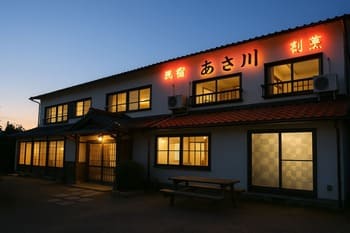

Minshuku vs. Minpaku (Airbnb-style stays)
You may see both listed on booking platforms, but they offer very different experiences.
Minpaku usually means renting a room or apartment without meals or interaction—more like self-service lodging.
A minshuku, on the other hand, often includes dinner and breakfast, and comes with warm hospitality that’s hard to find elsewhere.
How to Find a Minshuku
It’s still difficult to search specifically for minshuku (as opposed to minpaku) on major booking platforms.
Most sites mix the two, or don’t categorize them clearly.
If you’re serious about finding a traditional minshuku,
your best bet may be to use a Japanese-language site like Jalan.net,
which allows you to filter by accommodation type—including minshuku.
The site is in Japanese, but with your browser’s translation feature,
it becomes a surprisingly doable (and even fun) experience.
Not the easiest route—but maybe that’s what makes it feel like an adventure.
1-7. Minpaku (Airbnb-style Lodging)
In recent years, minpaku—a form of private lodging often compared to Airbnb—has become increasingly common in Japan.
If you’ve used Airbnb in other countries, the experience here is quite similar: you rent a room or an entire apartment, usually without meals or host interaction.
This type of accommodation is ideal for travelers who prefer privacy and independence.
You won’t find home-cooked meals or cultural experiences here, but you’ll have a place to yourself—sometimes at a great price.
Minpaku options are available in both cities and rural areas, and some offer kitchenettes or washing machines, which can be convenient for longer stays.
But here’s a quiet question:
If you came all the way to Japan, do you really want to spend your whole trip living exactly the way you do back home?
For some, that sense of familiarity and freedom is perfect.
For others, it might feel like something’s missing.
In any case, if solitude and self-sufficiency are what you value most, minpaku can be a very practical choice.
1-8. Hostels
Hostels in Japan are ideal for budget-conscious travelers, solo adventurers, long-stay visitors,
or anyone who’s more interested in meeting people than ordering room service.
Most offer shared dormitory-style rooms with bunk beds, although some have private rooms available as well.
You’ll usually find shared bathrooms, a small kitchen, and a common lounge—perfect for swapping travel tips or just charging your phone next to someone from across the world.
Shared kitchens are common, though most people keep it simple—instant noodles, convenience store food, or the occasional “just toast and coffee” kind of breakfast.
And hey, hearing the gentle snore of a stranger from the other side of the world… that’s a kind of cultural exchange too, right?
What sets Japanese hostels apart is their cleanliness and organization.
Even in the cheapest ones, you’ll often find tidy facilities, polite staff, and a quiet-at-night atmosphere that’s very… Japanese.
That said, don’t expect cultural immersion or luxury.
Hostels are more about “the traveler’s lifestyle”—practical, simple, and a bit chaotic in a good way.
If you’re someone who finds joy in sharing a breakfast table with strangers or picking up tips from travelers heading in the opposite direction,
this might be your favorite kind of stay.
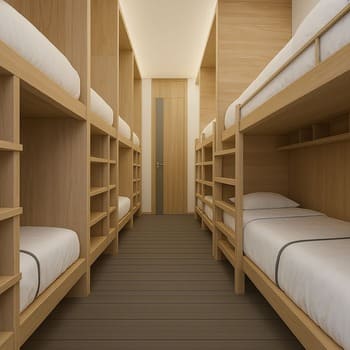
Still not sure if hostels are your thing?
If you’ve never stayed in one, it can be hard to picture what it’s really like—especially in Japan, where things are often more organized (and quieter) than you might expect.
If you’re curious to explore more, this article offers a great beginner-friendly overview:
👉 What Is a Hostel? Key Differences from Hotels and Guesthouses (hotelsmart.jp)
It’s in Japanese, but a quick browser translation will give you the gist.
It might help you decide if you’re ready to trade a little privacy for a more social, flexible way to travel.
1-9. Capsule Hotels
If you’re willing to trade space and comfort for affordability and novelty, capsule hotels are worth a try.
These uniquely Japanese accommodations offer compact sleeping pods that are just big enough for one adult to lie down.
It’s like spending the night inside a drawer.
Or maybe a song about the batteries inside your TV remote will come to you, fully formed.
Or you’ll dream of being King Tut.
Either way, you might find it strangely fascinating.
Capsule hotels used to be known mainly as a last resort for salarymen who missed the last train.
But in recent years, many of them have reinvented themselves with modern amenities, chic designs, and even gender-separated floors.
Some are surprisingly stylish, with personal TVs, USB ports, and even saunas.
That said, if you’re even slightly claustrophobic, this is not the experience for you.
Let me repeat: this is not the experience for you.
What awaits you may be a nightmare—in more ways than one.
Meals are rarely included, though some places offer simple breakfast options or vending machines with light snacks.
They’re not ideal for long stays, but if you’re looking for a cheap, clean, and uniquely Japanese overnight stop—this is it.
You can find capsule hotels on Booking.com by selecting “capsule” as the accommodation type.
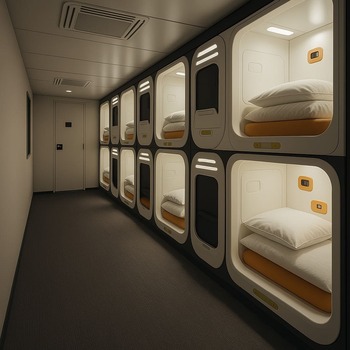
1-10. Love Hotels (No-Tell Motels)
An unconventional option, but one that might surprise you—in a good way.
Love hotels were originally designed for couples seeking a bit of privacy at the end of a date.
As such, staff interaction is kept minimal, and many hotels allow you to check in without ever showing your face.
Meals usually aren’t included, but some places offer delivery service, almost like room service—but with zero judgment.
If you—or your partner—feel hesitant about the idea of staying at a love hotel, you’re not alone.
For what it’s worth, I often use clothespins to reseal snack bags, and I regularly scratch my back with a pen.
Some things just work, even if they weren’t originally designed that way.
Rooms tend to be larger than those in business hotels, and some come with wildly unique amenities:
colored lights, karaoke machines, game consoles, massage chairs, jacuzzis… you name it.
It’s not exactly “traditional Japanese hospitality,” but it’s a form of hospitality nonetheless.
💰 How Much Does a Love Hotel Cost?
- Overnight stays (around 10 p.m. to 10 a.m.): $35–$70
- Short stays (1–3 hours): $20–$50
- Day-use plans (afternoon use): $35–$50
That’s on par with or even cheaper than business hotels—and for a far more spacious and entertaining experience.
It’s also one of the few hotel types where you can spontaneously decide to stay without a reservation.
Yes, it’s a bit quirky. Yes, it’s very Japanese.
But for curious travelers, it’s one of those “only in Japan” moments that make your trip memorable.
You can find some love hotels on Booking.com by selecting “Love Hotels” as the accommodation type,
but the selection is limited. For the full experience, check out Japanese-only websites specializing in love hotels.
Your browser’s translation function might just become your new best friend.
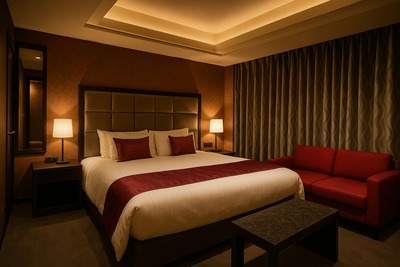
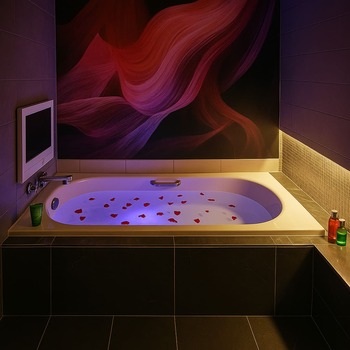
Couples.jp – A Love Hotel Search Site in Japan (External Link)
2. Quick Comparison: Which Type of Accommodation Suits You Best?
Not sure which accommodation type is right for you?
Here’s a quick side-by-side comparison to help you decide—based on price, meals, comfort, and more.
Think of it as your cheat sheet to choosing a place to stay in Japan.
| Type | Evaluation | Approximate Price (per person per night) | Dinner | Breakfast | Location | Room Size | Cleanliness | Other Selling Points |
|---|---|---|---|---|---|---|---|---|
| Business hotels | 4/5 (Very Good) | $40+ | Not included | Included | Urban area | Moderate | Good | – |
| Mid-Range Hotels | 4/5 (Very Good) | $80+ | Included | Included | Tourist area (Hot spring resort) | Spacious | Very Good | Often features shared hot springs. |
| Luxury Resort Hotels | 4/5 (Very Good) | $250+ | Included | Included | Tourist area (Hot spring resort) | Spacious | Excellent | Resort atmosphere and luxury. |
| International Hotel Chains | 3/5 (Good) | $300+ | Limited | Limited | Urban area | Varies (Moderate to Spacious) | Excellent | High-quality service and excellent cleanliness. |
| Ryokan | 5/5 (Excellent) | $250+ | Included | Included | Tourist area (Hot spring resort) | Spacious | Excellent | Some rooms may have an open-air bath. Traditional Japanese experience. |
| Minshuku (Guest house) | 4/5 (Very Good) | $40+ | Included | Included | Tourist area (Hot spring resort) | Moderate | Good | Affordable and homey atmosphere. |
| Minpaku (AirBnB) | 3/5 (Good) | $50+ | No | No | Urban area | Moderate | Good | You will have a private space throughout your stay. |
| Hostels | 3/5 (Good) | $20+ | No | No | Urban area | Compact | Good | – |
| Capsule Hotels | 2/5 (Fair) | $15+ | No | No | Urban area | Compact | Fair | – |
| Love hotels (No-tell motel) | 5/5 (Excellent) | $35+ | No | No | Urban area | Varies (Moderate to Spacious) | Good | Amusement facilities may be available. Explore the underground culture of Japan. |
3. How to Choose the Right Place to Stay – My Recommendation
Planning a trip to Japan can feel overwhelming—so many places to go, so many types of places to stay.
But instead of comparing every option endlessly, it might help to ask yourself:
What kind of experience do I want?
Below is a sample two-week itinerary that balances comfort, cultural immersion, and a bit of fun.
Think of it not as a prescription, but as inspiration to help you shape your own unforgettable stay.
🧳 Sample Travel Plan (14 nights)
- Urban Areas (e.g., Tokyo, Kyoto): 6 nights
- Sightseeing Areas (e.g., Hakone, hot spring towns): 5 nights
- Okinawa: 3 nights
🏨 Accommodation Breakdown
🏙 Urban Areas
- 5 nights in a business hotel
- 1 night in a love hotel
Why?
In big cities, spending heavily on accommodation often doesn’t bring much extra value.
A reliable and affordable base is usually the smarter choice.
That said, adding one night in a love hotel can turn into a quirky and unforgettable highlight.
🏞 Sightseeing Areas
- 1 night in a luxury ryokan
- 4 nights in a mid-range travel hotel
Why?
Every visitor should experience a luxury ryokan at least once—it’s a gateway to Japan’s traditional hospitality.
But for the rest of your stay, a solid mid-range hotel with hot springs and dependable service offers great value and comfort.
🏝 Okinawa
- 1 night in a luxury resort hotel
- 1 night in a mid-range hotel
- 1 night in a minshuku (guest house)
Why?
This mix lets you enjoy the best of everything:
resort-style luxury, peace of mind, and a taste of everyday Japanese life—all in one stop.
💡 Pro Tip
Hotel prices can skyrocket on weekends and holidays.
If you’re flexible, consider booking higher-end accommodations during weekdays (when prices tend to drop),
and shifting to budget-friendly options when rates climb.
It’s a smart way to maximize experience—without minimizing your wallet.
You might also like:


